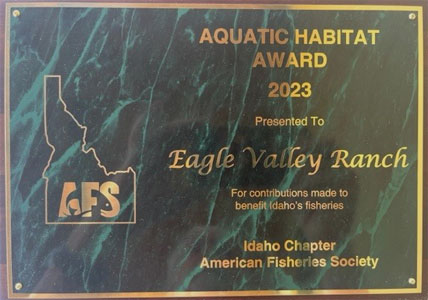American Fisheries Association Aquatic Habitat Award
By:
Jeff DiLuccia Val and I assembled Eagle Valley Ranch (EVR) in a series of real estate transactions from 2003 to 2006. The ranch encompasses 5,900 contiguous deeded acres and 12,000 acres of grazing leases on Bohannon Creek and the Lemhi River 12 miles east of Salmon, ID. It is located on the western slopes of the Beaverhead Mountains of the Bitterroot Range on the border of Idaho and Montana about 20 miles north of Lemhi Pass where Lewis and Clark crossed the Continental Divide in August 2005. They were greatly disappointed to see endless mountains ahead instead of the Pacific Ocean and find that the Salmon River was not navigable. They negotiated with the local Shoshone tribe who were relatives of Sacajawea for horses and a guide to take them over the Lost Trail Pass into Montana where they had to spend a second winter before floating down the Clearwater, Snake and Colombia to the Pacific the following Spring.
Val and I assembled Eagle Valley Ranch (EVR) in a series of real estate transactions from 2003 to 2006. The ranch encompasses 5,900 contiguous deeded acres and 12,000 acres of grazing leases on Bohannon Creek and the Lemhi River 12 miles east of Salmon, ID. It is located on the western slopes of the Beaverhead Mountains of the Bitterroot Range on the border of Idaho and Montana about 20 miles north of Lemhi Pass where Lewis and Clark crossed the Continental Divide in August 2005. They were greatly disappointed to see endless mountains ahead instead of the Pacific Ocean and find that the Salmon River was not navigable. They negotiated with the local Shoshone tribe who were relatives of Sacajawea for horses and a guide to take them over the Lost Trail Pass into Montana where they had to spend a second winter before floating down the Clearwater, Snake and Colombia to the Pacific the following Spring.
Salmon and steelhead used to spawn in huge numbers in the Lemhi in what is the longest salmon run in the world. Their numbers have been greatly reduced by commercial fishing, loss of habitat and eight dams on the Colombia and Lower Snake Rivers. Classmates who went on the Colombia River trip in 2017 would understand. The dams not only impede adult salmon returning to spawn but also make it much more difficult for young salmon to survive the trip back to the sea. These fish are used to be carried downstream by fast, cold waters but when they reach the stagnant reservoirs behind the dams they become disoriented and subject to predation. The Boneville Power Administration that operates the dams that provide cheap hydro power and irrigation to much of the Northwest has to pay millions for fish restoration projects. That and the Pacific Coastal Recovery Fund of NOAA provide the funding for habitat rehabilitation projects designed and implemented by the Idaho Department of Fish and Game (IDFG) on EVR.
The Lemhi River and many other streams were straightened out in the 1950s to prevent flooding and enable farming and development along their banks. The river was forced into a narrow channel with riprap that prevented it from meandering through the valley and creating the side channels, pools and wetlands favored by young fish. These fish need to gain weight and mature in sheltered waters before they attempt the arduous journey back to the ocean. Jeff DiLuccia of IDFG describes their plight as having to survive in a garden hose or on a treadmill.
Government funding alone is not enough to help the fish. The cooperation of private landowners who control most of the riparian areas is critical. Lemhi County is the size of Connecticut and has only 7,700 people. But 93% of the land is owned by the Federal Government while a lot of the salmon habitat is on private lands along the streams. In the arid, mountainous West irrigation from surface waters is the only effective way to grow pasture and hay needed for cattle operations. And cattle ranching along with recreation and government agencies are the three main pillars of the local economy.
These factors led us to donate two conservation easements in 2008 and 2014 to the local Lemhi Regional Land Trust tailored specifically to preserve the agricultural and scenic values of the property in perpetuity while allowing the flexibility to continue the cattle operations that are so important to the local economy and way of life. The existence of these easements in turn allowed IDFG to design the multi-year Lemhi River Restoration Project for which we got The Aquatic Habitat Award by the Idaho Chapter of the American Fisheries Society on May 10, 2023. The project is the largest river restoration project in Idaho and is expected to be completed in the next couple of years. The accompanying short video gives an overview of the rationale and scope of the project.